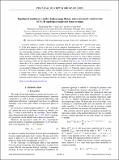| dc.contributor.author | Zhu, Chenchang | |
| dc.contributor.author | Lan, Tian | |
| dc.contributor.author | Wen, Xiao-Gang | |
| dc.date.accessioned | 2022-02-04T00:34:14Z | |
| dc.date.available | 2021-10-27T20:35:10Z | |
| dc.date.available | 2022-02-04T00:34:14Z | |
| dc.date.issued | 2019 | |
| dc.identifier.issn | 1550-235X | |
| dc.identifier.issn | 2469-9969 | |
| dc.identifier.uri | https://hdl.handle.net/1721.1/136392.2 | |
| dc.description.abstract | © 2019 American Physical Society. A discrete nonlinear σ-model is obtained by triangulate both the space-time Md+1 and the target space K. If the path integral is given by the sum of all the simplicial homomorphisms φ:Md+1→K (i.e., maps without any topological defects), with an partition function that is independent of space-time triangulation, then the corresponding nonlinear σ-model will be called topological nonlinear σ-model which is exactly soluble. These exactly soluble models suggest that phase transitions induced by fluctuations with no topological defects usually produce a topologically ordered state and are topological phase transitions. In contrast, phase transitions induced by fluctuations with all topological defects give rise to trivial product states and are not topological phase transitions. Under the classification conjecture of Lan-Kong-Wen [Phys. Rev. X 8, 021074 (2018)2160-330810.1103/PhysRevX.8.021074], it is shown that, if K is a space with only nontrivial first homotopy group G, which is finite, then these topological nonlinear σ-models can already realize all 3+1D bosonic topological orders without emergent fermions, which are described by Dijkgraaf-Witten theory with gauge group π1(K)=G. Under the similar conjecture, we show that the 3+1D bosonic topological orders with emergent fermions can be realized by topological nonlinear σ-models with π1(K)= finite groups, π2(K)=Z2, and πn>2(K)=0. A subset of these topological nonlinear σ-models corresponds to 2-gauge theories, which realize and may classify bosonic topological orders with emergent fermions that have no emergent Majorana zero modes at triple string intersections. | en_US |
| dc.description.sponsorship | NSF Grant (DMR-1506475) | en_US |
| dc.description.sponsorship | NSF Grant (DMS-1664412) | en_US |
| dc.description.sponsorship | Deutsche Forschungsgemeinschaft (DFG ZH 274/1-1) | en_US |
| dc.language.iso | en | |
| dc.publisher | American Physical Society (APS) | en_US |
| dc.relation.isversionof | https://dx.doi.org/10.1103/PHYSREVB.100.045105 | en_US |
| dc.rights | Article is made available in accordance with the publisher's policy and may be subject to US copyright law. Please refer to the publisher's site for terms of use. | en_US |
| dc.source | APS | en_US |
| dc.title | Topological nonlinear σ -model, higher gauge theory, and a systematic construction of 3 + 1 D topological orders for boson systems | en_US |
| dc.title.alternative | Topological nonlinear σ-model, higher gauge theory, and a systematic construction of 3+1D topological orders for boson systems | en_US |
| dc.type | Article | en_US |
| dc.contributor.department | Massachusetts Institute of Technology. Department of Physics | en_US |
| dc.relation.journal | Physical Review B | en_US |
| dc.eprint.version | Final published version | en_US |
| dc.type.uri | http://purl.org/eprint/type/JournalArticle | en_US |
| eprint.status | http://purl.org/eprint/status/PeerReviewed | en_US |
| dc.date.updated | 2021-07-08T15:54:47Z | |
| dspace.orderedauthors | Zhu, C; Lan, T; Wen, X-G | en_US |
| dspace.date.submission | 2021-07-08T15:54:48Z | |
| mit.journal.volume | 100 | en_US |
| mit.journal.issue | 4 | en_US |
| mit.license | PUBLISHER_POLICY | |
| mit.metadata.status | Publication Information Needed | en_US |
